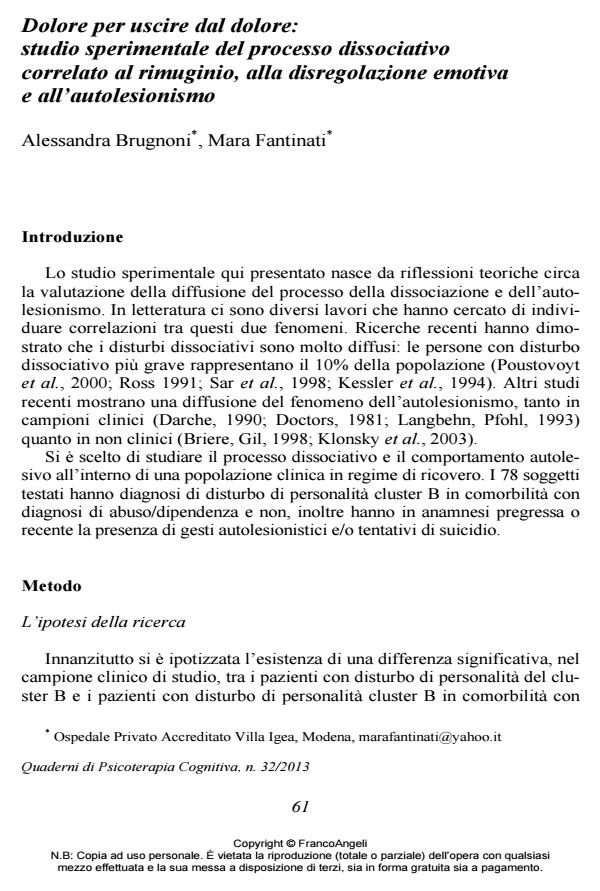Dolore per uscire dal dolore: studio sperimentale del processo dissociativo correlato al rimuginio, alla disregolazione emotiva e ll’autolesionismo
Titolo Rivista QUADERNI DI PSICOTERAPIA COGNITIVA
Autori/Curatori Alessandra Brugnoni, Mara Fantinati
Anno di pubblicazione 2013 Fascicolo 2013/32
Lingua Italiano Numero pagine 17 P. 61-77 Dimensione file 680 KB
DOI 10.3280/QPC2013-032005
Il DOI è il codice a barre della proprietà intellettuale: per saperne di più
clicca qui
Qui sotto puoi vedere in anteprima la prima pagina di questo articolo.
Se questo articolo ti interessa, lo puoi acquistare (e scaricare in formato pdf) seguendo le facili indicazioni per acquistare il download credit. Acquista Download Credits per scaricare questo Articolo in formato PDF

FrancoAngeli è membro della Publishers International Linking Association, Inc (PILA)associazione indipendente e non profit per facilitare (attraverso i servizi tecnologici implementati da CrossRef.org) l’accesso degli studiosi ai contenuti digitali nelle pubblicazioni professionali e scientifiche
L’obiettivo della ricerca sperimentale è stato quello di indagare il processo dissociativo su un campione clinico di 78 pazienti, affetti da disturbi della personalità cluster B con o senza abuso di sostanze stupefacenti. La letteratura ha definito l’autolesionismo sia come una strategia di evitamento emozionale (Chapman, Gratz, Brown, 2006) sia come un’azione risolutiva di uno stato dissociativo (Sachsse, Von Der Heyde, 2002) conseguente ad uno stato di analgesia (Matsumoto, Imamura, Chiba, 2008). Oggi con il termine dissociazione ci si può riferire contemporaneamente a un meccanismo di difesa, a uno stato alterato di coscienza o alla mancata acquisizione o alla perdita dell’integrazione tra i sistemi o i moduli mentali (Van der Hart, Nijenhuis, Steele, 2006). Pertanto si è scelto di analizzare il processo dissociativo correlandolo con la presenza di gesti autolesivi, con la difficoltà a regolare le emozioni e con l’utilizzo del rimuginio cognitivo; ipotizzando una correlazione significativa tra loro. Le analisi statistiche correlazionali e di regressione lineare multipla hanno messo in luce dati significativi e utili per l’intervento terapeutico.
Parole chiave:Dissociazione, autolesionismo, disturbi della personalità del cluster B
Alessandra Brugnoni, Mara Fantinati, Dolore per uscire dal dolore: studio sperimentale del processo dissociativo correlato al rimuginio, alla disregolazione emotiva e ll’autolesionismo in "QUADERNI DI PSICOTERAPIA COGNITIVA" 32/2013, pp 61-77, DOI: 10.3280/QPC2013-032005